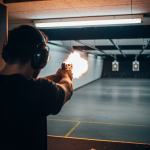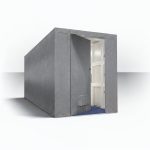A safe room exists for one purpose: to preserve life when conditions outside the door become dangerous. Whether built to withstand storms, intrusions, or blasts, the integrity of the space depends on every surface. Walls, ceilings, and floors must resist impact and penetration while maintaining their structure under pressure. Traditional construction materials provide a starting point, but on their own they often leave weaknesses where joints meet or where forces exceed design expectations. This is where polyurea has become increasingly relevant. Its application creates a continuous protective layer that improves both the strength and the resilience of safe room construction.
The role of polyurea in structural reinforcement
Polyurea is applied as a liquid spray and cures within seconds into a flexible yet highly durable membrane. When bonded to concrete, steel, or wood, it forms a continuous skin that covers joints, seams, and transitions without leaving gaps. This seamless quality addresses one of the most common points of failure in safe rooms. A strong wall may resist impact, but if the seams between panels fail, the entire structure loses its integrity. Polyurea eliminates those weaknesses by creating a bonded barrier across every surface.
Another property that makes polyurea suitable for safe rooms is its combination of hardness and elasticity. Unlike brittle coatings that crack under stress, polyurea stretches slightly, absorbing energy without breaking apart. In situations where impacts or blasts create sudden force, this flexibility allows the structure to deform slightly while remaining intact. The coating acts as a containment layer, holding back fragments and debris that would otherwise become hazards within the space.
Application on different substrates
Concrete remains one of the most common materials for safe room walls. It provides mass and compressive strength but it is prone to cracking under tensile forces. A polyurea coating bonds to the surface of the concrete and holds fragments together if cracks develop. Instead of spalling outward under impact, the concrete remains contained behind the flexible membrane. This not only protects the structural element but also prevents debris from injuring occupants.
When applied to steel, polyurea provides corrosion resistance in addition to impact performance. Steel safe rooms exposed to humidity or moisture may rust over time, reducing their strength. A continuous polyurea layer seals the steel from air and water, extending its lifespan. On wooden structures, polyurea adds both moisture protection and fire resistance, transforming a vulnerable surface into a more reliable barrier.
Protection against blasts and intrusions
Safe rooms built in regions threatened by tornadoes or hurricanes require resistance to high-velocity debris. Studies have shown that polyurea applied over standard building materials can stop projectiles that would otherwise penetrate. In blast scenarios, such as those considered in military or high-security environments, polyurea acts as an energy-absorbing liner. It contains secondary fragments, reducing injury risks from flying debris inside the room.
Intrusion resistance is another area where polyurea contributes. By reinforcing doors and entry points, the coating makes forced entry more difficult. While it does not replace heavy locking mechanisms or structural reinforcements, it adds another barrier that delays penetration, buying valuable time for occupants.
Durability and maintenance advantages
A safe room must remain ready for use at all times, often sitting idle until the moment it is needed. Materials that degrade under environmental conditions compromise readiness. Polyurea’s resistance to water, chemicals, and ultraviolet light means it retains its properties over time. Unlike paints or thin coatings that may peel or flake, polyurea remains bonded to the substrate, providing consistent performance without the need for frequent maintenance.
This durability reduces long-term costs. Once applied, the coating can last decades with minimal attention. For families or institutions investing in safe rooms, this stability means confidence that the space will function as intended even after years without use.
Design flexibility
Polyurea is applied with spray equipment, which allows it to conform to complex geometries. Safe rooms often include vents, corners, and entry points where different materials meet. These are the very areas where leaks, cracks, or penetrations are most likely. The ability of polyurea to coat irregular shapes ensures that no vulnerable areas remain exposed. This adaptability simplifies design by reducing the need for additional seals or joint treatments.
Balancing comfort with protection
A safe room must be strong, but it must also remain habitable for as long as people occupy it. Polyurea contributes here by improving insulation and reducing moisture infiltration. A sealed environment helps maintain stable temperatures and limits dampness. The absence of flaking or dusting means the air remains cleaner, which becomes important in confined spaces.
Conclusion
Safe rooms are built to provide certainty in uncertain situations. Their performance depends not just on the strength of walls or locks, but on the ability of the entire enclosure to resist impact, pressure, and intrusion. Polyurea has proven itself as a material that meets these requirements by creating a seamless, flexible, and durable protective layer. It reinforces concrete, seals steel, and transforms wood, addressing both structural integrity and occupant safety.
By absorbing energy, containing fragments, and resisting environmental degradation, polyurea ensures that safe rooms remain reliable over time. Its use reflects a broader approach to construction that values both strength and resilience. For those responsible for building or maintaining these spaces, polyurea provides not just a coating but a safeguard that aligns with the ultimate goal of safe rooms: preserving life when it matters most.






